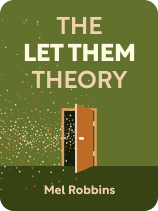

This article is an excerpt from the Shortform book guide to "The Let Them Theory" by Mel Robbins. Shortform has the world's best summaries and analyses of books you should be reading.
Like this article? Sign up for a free trial here.
What’s The Let Them Theory about? Do you have a need to control everything?
There’s a simple, but powerful framework for reclaiming your time and mental energy: Stop trying to control other people. In Mel Robbins’s The Let Them Theory, she explains how accepting others as they are while taking responsibility for your own actions can transform your relationships, reduce stress, and help you build the life you want.
Read more in our brief overview of The Let Them Theory.
Overview of The Let Them Theory
We all have a deep need to feel in control, which is why we try to shape the people and situations around us to fit our expectations and preferences. But this is an exercise in futility that only makes us frustrated and anxious and sets us up for conflict with the people in our lives. In The Let Them Theory, Mel Robbins contends that we need to shift our mindsets so we can stop wasting energy trying to control other people’s thoughts, feelings, and actions. She writes that the best way to keep other people from sapping your energy is to “Let Them” be who they are, while focusing on what you can control: yourself and your own responses.
Robbins explains that this simple shift frees you from the draining cycle of trying to manage what other people think and do. Instead, by accepting reality as it is and detaching from others’ choices, you can take full responsibility for your life and happiness. When you acknowledge the truth that you can’t change others—only yourself—you can stop trying to derive your sense of agency and control from your influence on others and instead find greater peace, confidence, and self-determination by focusing on your own thoughts and actions.
Robbins is an author, speaker, and podcast host known for developing a method she calls the “5 second rule”: counting down from five to one and taking action when you get to one. The Let Them Theory grew out of a viral Instagram video where Robbins explained the basic premise of her theory that we should stop wasting our time and energy on trying to get people to live up to our expectations.
Discussion questions and exercises for this book
What Is the Let Them Theory?
Robbins’s Let Them Theory teaches us to detach from situations and behaviors that are outside our sphere of influence. It involves shifting your mindset to take control of what you do and how you spend your time and energy. She explains that we have a natural need to feel like we’re in control because we fear that things will go wrong if we aren’t in control—and we think that if we can just influence those around us, we’ll find a way to make our lives better and avert potential problems. But we can’t control other people’s actions or opinions, and trying to do so just makes us more stressed, anxious, miserable, and drained. It saps our energy, robs us of our peace of mind, and distracts us from creating the lives we want.
To escape the trap of trying to control what other people do and say, Robbins contends you have to acknowledge that you can’t manage everyone else’s opinions, judgments, and feelings and redirect your energy and focus to what you can control. She explains that to do that, you can use two simple phrases: “Let Them” and “Let Me.”
“Let Them” and “Let Me”
When you say “Let Them,” you consciously detach from other people’s behaviors, opinions, and emotional reactions. This frees you from wasting time and energy on things you can’t control or wishing you could change the people around you—people who might not actually want to change.
Robbins says that saying “Let Them” saves you time and energy and might make you feel relieved, but she cautions that it might also make you feel superior because you can blame the other person for their “bad” behavior or “wrong” opinions and move on. It can also lead you to withdraw from the situation and from your connection with others. This is where “Let Me” comes in.
“Let Me” means you take responsibility for your own actions, thoughts, and feelings in response to the situation. Robbins explains that when you say “Let Me,” you empower yourself to focus on your values, your attitude, and your actions as you move forward. By combining “Let Them” with “Let Me,” you regain control of the situation—and give grace to others.
For example, when a family member offers unsolicited advice about your life choices, you can “Let Them” have their opinion without internalizing it. After all, their perspective isn’t a reflection of your values or the validity of your decisions. Then, you can remind yourself to “Let Me” decide how to move forward, given the values and goals you’ve defined for yourself.
Robbins explains that practicing “Let Them” and “Let Me” doesn’t require you to give up on improving a situation or to let go of your feelings: Her method just gives you a way to free yourself from your natural tendency to try to control what you can’t control. She contends that the key to making your relationships healthier and your life happier is to use your own goals, priorities, values, and feelings—rather than what others say and think—to determine what you should do and how you should do it.
Robbins explains that as you integrate the Let Them Theory into your daily life, you’ll reduce your stress levels and increase your sense of empowerment to build the life that you want. Situations that once made you feel frustrated or anxious will become opportunities to exercise your newfound ability to let go of what you can’t control and direct your energy toward more constructive pursuits. While “Let Them” involves accepting others for who they are, “Let Me” requires taking full responsibility for your own life. It’s about recognizing that you are the only one who can create the changes you want.
Why Do “Let Them” and “Let Me” Work?
Robbins points out that our time and energy are precious resources that we need to invest wisely. When we allow external factors to drain us emotionally and mentally, we deplete the reserves we need to work toward our goals, deepen our relationships, and improve our well-being. Stress and negative emotions are a natural consequence of letting other people deplete our time and energy, and these can have detrimental effects on our physical and mental health, with results like burnout, anxiety, and depression. Robbins contends that if you protect your energy with the Let Them Theory, you can carve out the space for a more positive, productive, and fulfilling life.
She also explains that when you stop trying to influence what other people say and do, you not only regain precious time and energy, but you learn to protect your emotional well-being, too. When you let go of the need to control others, you free yourself from the frustration and emotional upheaval that comes with trying to manage situations beyond your influence. This newfound peace of mind allows you to approach life with greater clarity and intention—and to better see situations and relationships for what they really are.
Underlying the Let Them Theory is the idea that you have to accept reality as it is, without judging it, without resisting it, and without wanting to change it into something that it’s not. Robbins characterizes the theory as a way to apply ideas promoted by Stoicism, Buddhism, detachment theory, and radical acceptance:
- Stoicism teaches us to focus on what we think and do, rather than fixating on the thoughts and actions of others.
- Buddhism and radical acceptance explain that we make ourselves miserable by wishing that reality were different and trying to change it.
- Detachment theory teaches that to avoid being miserable and anxious about things that are outside our control, we have to step back and emotionally distance ourselves.
How Can You Use the Let Them Theory?
Robbins contends that the Let Them Theory can be applied to all areas of your life, from work to friendships to romantic relationships. At its core, conserving your energy and protecting your peace with the Let Them Theory is a two-step process:
1. Recognize and acknowledge situations or behaviors that are outside your control. In these moments, when you notice you’re reacting negatively to someone’s choices, consciously say “Let Them” to yourself, signaling your detachment from judging them and letting go of your need to change, control, or criticize them.
2. Shift your focus to what you can control: your thoughts, actions, and responses. Reflect on how you want to think, act, and speak, and how you can align your next steps with your core values. Say “Let Me” and take a deep breath, resetting your body’s stress response, and reclaim your responsibility to act positively.
Robbins explains that you can use the Let Them Theory to manage the stress of your everyday life more productively. When you’re feeling annoyed and stressed by your friends’ constantly changing plans, your colleague’s difficulty meeting a deadline, the crowd at the grocery store, or the person having a loud conversation on the train, that’s the perfect time to say, “Let Them.” Robbins writes that these stressors automatically activate your brain’s stress response but by stopping and thinking “Let Them,” you can reset this response to signal to your brain that whatever’s happening isn’t worth getting stressed over.
This method helps you take control of how you spend your time and energy. When you remind yourself to let other people manage their actions, you stop yourself from letting their behavior amp up your stress levels and bring down your mood. Then, when you refocus on what you’re going to say or do in the situation, you signal to your brain that you can’t control the situation you’re feeling stressed about—but you can control how you respond. As for figuring out how to respond, Robbins recommends considering whether the incident will bother you in an hour, or a week, or a year: If it won’t, then you might not have to do anything. But if it’s really going to bother you, then it’s worth putting in the time and effort to change it.
Ahead, we’ll consider how applying the Let Them theory can help you improve your relationships with others and even with yourself.
Take Control of Your Relationships
Saying “Let Them” and “Let Me” gives you a way to take responsibility for your relationships. Other people’s words and actions can send us on an emotional rollercoaster: When we internalize the negative things they say and do, we often feel inferior. For example, if your colleague walks into the office one morning and immediately snaps at you, you’d likely feel you must have done something wrong that justifies their rudeness. But they might just be in a bad mood because their shoelace broke or they missed their train—circumstances that don’t involve you.
Conversely, as we discussed earlier, it can make you feel superior to just think “let them” and dismiss your colleague’s behavior—thinking you’re the bigger person who’s above such pettiness or judging them for being rude. But that wouldn’t be a productive way forward, as it still involves judgment rather than true acceptance.
Robbins explains that you’re responsible for building the relationships you want with other people. In the situation with your grumpy colleague, that means that you wouldn’t respond to their rudeness in kind, but instead look at them with empathy and figure out how you can make their day better. Robbins notes that if you say “Let Them” without following it up with “Let Me,” then you can end up feeling isolated from others. It’s by saying “Let Me” that you exercise your agency to be the person you want to be—for example, the kind of coworker who speaks to your colleagues with the consideration they deserve.
The same principle applies to friendships, too: Robbins explains you have to create the community you desire by adapting to the evolution of your friendships over time. When friends move away, prioritize new connections, or have less time for you, you need to say “Let Them” instead of clinging tightly or feeling hurt. At the same time, use “Let Me” to consider what matters most in adult friendships: proximity, timing, and energy. Proximity refers to physical closeness, which creates opportunities for interaction. Timing involves being at similar life stages. Energy is the effort you put in nurturing the friendship. If these are lacking, you can take action to realign yourself with a friend who seems distant—or make new connections.
Robbins notes that you can take the same approach to romantic relationships as well. When you’re dating someone, you have to “Let Them” show you who they really are, what they want in life, and whether you’re a priority to them. If they’re not the kind of person you want to be with, then you can let the relationship go to make space for someone else who can offer the love, commitment, and compatibility you deserve. No relationship is perfect, and every relationship hits rough patches. But if you agree on your values and support each other’s dreams, are willing to put in the effort to make the relationship work, and can accept each other as you are, then you can love them for who they are rather than for who you wish they could be.
Stop Being Stressed Out by Other People’s Opinions
The Let Them Theory also works when it’s what other people think and say—rather than what they do—that stresses you out. Inevitably, people will have and express negative opinions about you. But if you let their opinions influence your decisions, then you give up control over what you do with your life. Robbins points out that just as we can’t change what thoughts pop into our own heads, it’s impossible to control what other people think. She recommends expecting that other people will think negative thoughts about you—and resolving to follow your own path anyway. Instead of letting your fear of other people’s negative opinions constrain you, you can make decisions you’re proud of and live according to your own values.
Navigating other people’s opinions can be especially difficult when those other people are your family since they’re with you for the long haul. Robbins explains that it’s important to think about why someone might have the opinion they do of you or your choices. That way, you can see things from their point of view—not so you can change their mind. (You probably won’t.) Rather, it’s so you can respect their perspectives, which were formed by their life experiences, and accept them as their imperfect (and perhaps judgmental) selves. This serves to deepen your relationship.
Let Go of Your Fear of Other People’s Emotional Reactions
In the same way that managing other people’s negative opinions isn’t your responsibility, it’s also not your responsibility to manage other people’s emotional reactions. When you make decisions to avoid disappointing someone, to keep someone from getting angry at you, or because you know they’ll make you feel guilty if you don’t, you’re letting other people’s emotions dictate your decisions. Robbins explains that it’s hard but necessary to set boundaries and “Let Them” react. In doing so, you give people space to feel their emotions, and you release yourself from feeling like you have to manage or fix those emotions for them.
She explains that most people have the emotional maturity of an eight-year-old: They’ve never learned to process their emotions and communicate their needs in a healthy way because many parents inadvertently teach their children to suppress their emotions instead of finding a healthy way to express them. But Robbins explains that when an adult wants to act like an eight-year-old, you should just “Let Them.” Then, when you remind yourself to “Let Me” decide how to respond, you realize that their emotions aren’t yours to manage and it’s up to you to choose how much time and energy you want to give them.
Robbins points out that sometimes, we’re the ones who are being emotionally immature. The Let Them Theory not only helps you feel more compassionate with people who have trouble managing their emotional reactions, but can also help you be more compassionate with yourself and your emotions. When you notice yourself getting angry or feeling frustrated, you can use “Let Them” to tell yourself to let those emotions wash over you. Then, you can use “Let Me” to remind yourself that you don’t have to react to the emotions you feel. You can’t control how you feel, but you can control what you say and do. You shouldn’t let your emotions dictate your decisions any more than you should let other people’s emotions determine what you do.
Stop Pressuring Other People to Change
If you’ve ever tried to push somebody else to change, then you know it almost never works. Instead, you have to create an environment of acceptance and love to enable people to make changes in their own time. We all have a fundamental need for autonomy and control over our lives, and we naturally resist attempts by others to force change because these attempts threaten this core need. However, when we feel fully accepted and loved unconditionally, we’re free to look inward and find our own motivation to grow.
Robbins recommends several steps to create this supportive environment: Practice radical acceptance of others without judgment, express unconditional love while separating who they are from behaviors you dislike, be patient as change happens naturally, celebrate positive steps, and provide resources only when asked. By modeling the positive changes you’d like to see rather than criticizing or controlling, you allow them space to decide for themselves that they want to change. The goal isn’t to enable self-destructive behavior but to provide the emotional safety that makes meaningful change possible. Paradoxically, when people feel truly accepted as they are, they become more willing and able to transform themselves.
Build a Healthier Relationship With Yourself
Finally, Robbins explains that you can use the Let Them Theory to improve the relationship you have with yourself. She notes that you are the only person that you’re guaranteed to spend the rest of your life with, and you owe it to yourself to make your happiness and dreams a priority. When you let other people do what they want to do (and resolve to not allow them to determine what you do), you decide to build the life you want without worrying about other people’s approval or validation. Robbins notes you can use “Let Them” and “Let Me” to give yourself the power to become your own source of happiness, to define what’s important to you, and to take control of how you work to turn your reality into the life you want.

———End of Preview———
Like what you just read? Read the rest of the world's best book summary and analysis of Mel Robbins's "The Let Them Theory" at Shortform.
Here's what you'll find in our full The Let Them Theory summary:
- A simple but powerful framework for reclaiming your time and mental energy
- How to detach from situations and behaviors that are outside your influence
- How the "let them" theory can be taken too far, and how to avoid it from happening






